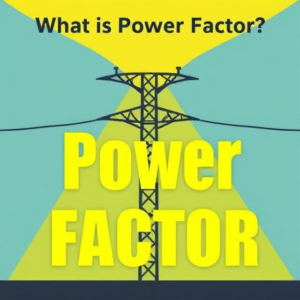What is Power Factor?
Power Factor (PF) is a number that tells us how efficiently electrical power is being used in an electrical system. It compares the real power (which is the useful power that does the work) with the apparent power (which is the total power supplied to the system). In simple terms, power factor shows how effectively you’re using electricity.

The Basics of Power
To understand power factor, we first need to know a bit about power. In an electrical system, there are two types of power:
- Real Power (Active Power) (measured in watts – W): This is the actual power that does the work, like running a motor, turning on a light, or charging a battery. This is the useful power that gets converted into energy to do things.
- Apparent Power (measured in volt-amperes – VA): This is the total power supplied by the source to the electrical system. It’s a combination of real power and reactive power (which doesn’t actually do useful work, but is necessary for creating magnetic fields in motors, etc.).
- Reactive Power (measured in volt-amperes reactive – VAR): This power doesn’t do any useful work but is necessary for maintaining the magnetic fields in devices like motors and transformers.
Power Factor Formula
The power factor is the ratio of real power (W) to apparent power (VA). Mathematically, it’s expressed as:
This ratio will always be a number between 0 and 1. The closer the power factor is to 1, the more efficiently the power is being used.
Power Factor and the Angle Between Voltage and Current
Power Factor is also related to the phase difference between the voltage and current waveforms in an AC (Alternating Current) circuit. These waveforms usually don’t perfectly align with each other. When there’s a phase difference, the voltage and current are not in sync, and this reduces the efficiency of the power usage.
- If voltage and current are perfectly in sync, the power factor is 1 (or unity), meaning 100% of the power is being used effectively.
- If there’s a phase difference, the power factor will be less than 1. The more the phase difference, the lower the power factor.
Types of Power Factor
- Power Factor of 1 (or Unity Power Factor): This is the ideal case, where all the electrical power is being used to do useful work. It happens when the current and voltage are perfectly in sync, which is typically the case with purely resistive loads like heaters or incandescent light bulbs. In this case:
- Power Factor Less Than 1: This happens in most real-world electrical systems. It means that some of the energy is being wasted. A low power factor can occur due to reactive loads like motors, transformers, or inductive devices that require reactive power to create magnetic fields but don’t use it for doing actual work. The power factor will be lower than 1, but ideally, you want it as close to 1 as possible.
- A power factor of 0.8 means that only 80% of the power is being used effectively, and the rest is wasted as reactive power.
Why is Power Factor Important?
- Efficiency: A higher power factor means you’re using electricity more efficiently. When the power factor is low, you’re wasting energy, which could result in higher electricity bills.
- Reduced Losses: Poor power factor can cause increased losses in the electrical system, especially in the wiring and electrical equipment like transformers. These losses are due to the unnecessary flow of reactive power.
- Electricity Bills: In some cases, utility companies charge more when your power factor is low, because the system has to supply more apparent power to meet the same amount of real power demand.
- Capacity: Electrical systems (like transformers and generators) need to be sized appropriately based on the apparent power. If the power factor is low, these systems need to handle more power than actually needed, which increases the size and cost of the equipment.
Improving Power Factor
To improve the power factor and make your electrical system more efficient, there are a few ways to correct it:
- Power Factor Correction Capacitors: Adding capacitors to the system can help counteract the effects of inductive loads (like motors), improving the power factor.
- Synchronous Motors: Using synchronous motors (which can be adjusted to correct the power factor) can also help in improving the power factor in industrial settings.
- Proper Sizing of Equipment: Ensuring that electrical equipment is appropriately sized for the load can also help maintain a good power factor.
Summary of Power Factor
- Power Factor is a measure of how efficiently electrical power is being used.
- It’s the ratio of real power to apparent power, and ranges from 0 to 1.
- A power factor of 1 means all the power is used effectively, while a lower value means power is being wasted.
- A low power factor results in higher energy losses, increased electricity costs, and larger equipment needs.
- Power factor correction methods can help make your system more efficient.
By improving power factor, you can save energy, reduce costs, and avoid unnecessary strain on your electrical system!
Power in AC Circuits
Three-Phase vs Single-Phase AC
Tags: Angle Between Voltage and Current, Improving Power Factor, Power Factor, Types of Power Factor, What is Power Factor


